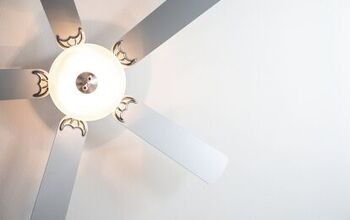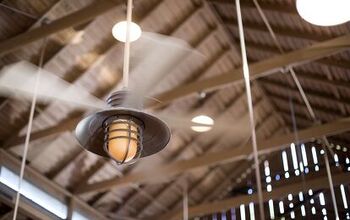Can LED Bulbs Be Used In Ceiling Fans? (Find Out Now!)

Because of their energy-saving properties, LED bulbs are becoming increasingly more common. They use 75% less energy than incandescent bulbs! But before you rush to change every bulb in your house, let’s talk about LED bulbs and ceiling fans.
Generally speaking, LED bulbs can be used in ceilings fans. You should know the minimum wattage the fan requires and its LED equivalent. If your ceiling fan is on a dimmer switch, the switch should be compatible with an LED bulb. Also, consider if your fan is connected to a remote or is an older style as LED bulbs may not be compatible.
Related Guide: Can I Put LED Bulbs In A Ceiling Fan?
Do You Need to Hire an Electrician?
Get free, zero-commitment quotes from pro contractors near you.

Why Some Fans Can’t Take LED Bulbs
The kind of bulb a ceiling fan can accept is dependent on the fan’s features. One of the biggest factors is understanding how much wattage your fan can take and knowing how to convert to the LED equivalent.
Ceiling fans often require more wattage than LED bulbs offer. But that doesn’t mean your ceiling fan can’t take an LED bulb. You just have to search for the proper one for your fan’s needs.
LEDs and Dimmer Switches
It’s common for ceiling fans to be wired to dimmer switches. Dimmers offer a cozy ambiance, especially in a dining room. If your fan is connected to a dimmer switch, then you must install an LED bulb with dimmer capabilities.
LED lights often require a dimmer designed specifically for their use. There’s a possibility that you may have to replace your switch if you are set on using LED lights.
Dimmers Can Damage the LED Bulb
Most ceiling fans are designed for incandescent, halogen, or CFL bulbs. When hooked up to a dimmer switch, these types of bulbs will function properly. Attempting to use the same dimmer switch with an LED bulb won’t get you the same results.
An LED light functions when an electrical current is sent directly to them. If you play around with the voltage being sent to it, the bulb could react by blinking or dying out shortly after installation.
Similarly, the way your fan is wired can also create some issues. If the fan and the dimmer use the same switch, an LED bulb should not be used. There is a potential for overheating.
The best scenario to use an LED bulb in a fan is when the switch controls the light and the fan is controlled by the pull chain.
The Life Expectancy of an LED Bulb in a Ceiling Fan
There are certain factors that cause LED bulbs to burn out faster than an incandescent light. Knowing what might blow out an LED bulb beforehand allows you to deal with the problem before there is one.
Vibration
We’ve all seen those ceiling fans that look like they’re going to take off any minute. With each rotation the fan swings like crazy. An LED bulb won’t work in this scenario.
This is because the vibration from the swinging fan damages the bulb, causing it to burn out, flash, or simply not work. If you notice your fan does this, you should balance the blades before installing LED bulbs.
Swinging typically isn’t a problem with newer fans because they tend to run more smoothly. Even so, if you run your fan constantly, it’s best not to use an LED bulb. The vibration from constant movement—even without shaking—will eventually wear out the LED light.
How to Balance Blades
To balance a ceiling fan, you will need a ceiling fan balancing kit. They come with one plastic clip and up to 5 balancing weights.
- Weigh each blade so you can start with the lightest one.
- Place the plastic clip lengthwise in the middle of the lightest blade.
- Reattach each blade before turning the fan on. If there’s still shaking, move the clip in small increments until the shaking stops. The clip marks the place where the weight should be placed.
- Clean the surface of the blade and glue the weight parallel with the clip.
- If there is still some shaking, repeat the steps starting with the next lightest blade.
Enclosed Light Fixtures
In order to perform their best, LED bulbs need room to breathe. If your fan’s light fixture is enclosed, there is potential that the bulb will be damaged.
The enclosed spaces do not allow for the proper amount of air circulation, which in turn could cause the circuit to overheat. This can cause the bulb to flicker or die long before it should. Certain LED bulbs are designed to work in enclosed fixtures. Using those could be the solution.
When a bulb is in a poorly ventilated area, it’s generally best to use one with a lower wattage. This goes for any bulb, not just LEDs. The lower wattage will prevent overheating, allowing the bulb to last longer.
Remote Controls
My bedroom ceiling fan is connected to a remote control. It was the easiest way to install a fan in the room without rewiring everything. In some cases, a remote control eliminates the hassle of pulling a chain.
However, remote controls are sometimes particular about what bulbs are used. Ceiling fan remotes usually require more wattage than LED bulbs put out. So, the best way to use an LED bulb in a ceiling would be if you can operate it with a pull chain.
Mixing Different Bulbs
It’s generally never a good idea to use incandescent bulbs and LED bulbs in the same fixture. This is especially true if the fixture is enclosed.
LED bulbs are damaged most frequently because of heat. Incandescent bulbs give off so much more energy which can cause LED bulbs to fail.
LEDs in Older Ceiling Fans
Today, the most common socket in a ceiling fan is a candelabra or E12 socket. These sockets are smaller and help reduce the energy emissions from the bulbs.
The lighting industry put energy emission regulations in place only about 15 years ago. This means that many homes still have medium sockets (E26 or E27) in their ceiling fans, which used to be the standard.
If that is the case for you, LED bulbs are still a possibility. You may just need to use an LED bulb with higher lumens equivalent to the power produced by medium-based incandescent bulbs.
Understanding Wattage Equivalence
Knowing the minimum wattage required for your fan or dimmer switch will help determine which LED bulb is equivalent. LED bulbs measure their light power in lumens as opposed to watts.
If the power of an LED bulb is listed in watts, it is not the same measurement as an incandescent bulb. For example, a 25-watt incandescent is the same as a 4-watt LED.
What you really want to understand is how many lumens a bulb has. The more lumens, the brighter the light will be. Below is a helpful conversion table.
| Bulb Type | Wattage | Lumens |
LED | 4 | 400 |
Incandescent | 25 | 375 |
Halogen | 20 | 375 |
| CFL | 7 | 400 |
Related Questions
Is it okay to leave your ceiling fan on 24/7?
Typically, it’s safe to leave your ceiling fan running for 8 consecutive hours. Any more than that can shorten the life of the fan. This is good to know in terms of using LED lights because if the fan runs constantly, the bulbs are at a higher risk for damage.
How do I make my LED ceiling fan brighter?
In order to brighten the light coming from the ceiling fan, you need to change it to a bulb with more lumens. The amount of lumens determines how bright the light will be.
Do You Need to Hire an Electrician?
Get free, zero-commitment quotes from pro contractors near you.

Summing It Up
LED bulbs save so much energy; it’s no wonder they’re so popular. While LED bulbs can be used in ceiling fans, they do have their limitations. Knowing the minimum wattage your fan takes and its LED equivalent is important before making the switch. Remember, the higher the lumens, the more output of light.

Brigid Levi is a wife, mother, and freelance writer who enjoys a good DIY project and creating beautiful spaces within her home. From cleaning and organization hacks to home decor ideas, she loves helping people in their quest to turn a house into a home. Her hobbies include pretending to be Joanna Gaines while updating her home with her husband and performing in local theater productions.
More by Brigid Levi




















![12 Washing Machine Brands to Avoid [with Recall Data]](https://cdn-fastly.upgradedhome.com/media/2023/07/31/9075781/12-washing-machine-brands-to-avoid-with-recall-data.jpg?size=350x220)




![How To Reset A Whirlpool Cabrio Washer [In 5 Easy Steps!]](https://cdn-fastly.upgradedhome.com/media/2023/07/31/9076531/how-to-reset-a-whirlpool-cabrio-washer-in-5-easy-steps.jpg?size=350x220)

